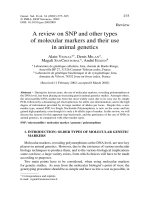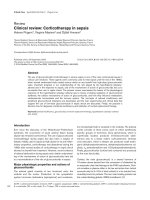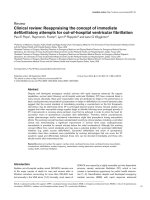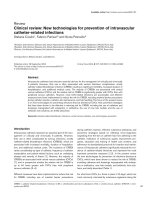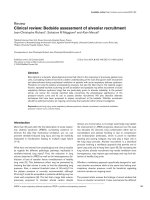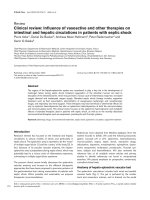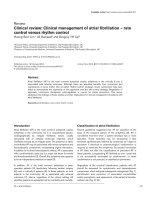Báo cáo khoa học: "Clinical review: Moral assumptions and the process of organ donation in the intensive care unit" pptx
Bạn đang xem bản rút gọn của tài liệu. Xem và tải ngay bản đầy đủ của tài liệu tại đây (62.94 KB, 7 trang )
382
ICU = intensive care unit.
Critical Care October 2004 Vol 8 No 5 Streat
Introduction
The great majority of intensivists are supportive of
transplantation and organ donation [1]. We often care for
organ transplant recipients and are well aware of the benefit
that these patients derive from transplantation [2].
Transplantation results continue to improve (despite
increasing case complexity) and this success has driven
demand for organ transplantation. At the same time, the
number of organs available for transplant has increased
comparatively less. Consequently, as waiting times of
potential recipients lengthen and some recipients die before
transplantation, transplant professionals increasingly describe
this tragedy as “the organ donor shortage” and vociferously
advocate for changes that might “increase the number of
organ donors” (including live-donor transplantation, which I
will not discuss here).
Historically, discussion of organ donation with families of
potential donors was performed by transplant professionals,
often nephrologists, who were introduced to families by
intensivists after brain death had been confirmed and the
family had been informed of the fact of death. Responsibility
for holding this encounter is now vested in trained ‘desig-
nated requestors’ (often ‘organ procurement coordinators’) in
some countries [3], and in intensivists in others [1]. The
present review examines the moral assumptions that underlie
this encounter and discusses two different approaches that I
have termed ‘utilitarian rationalism’ and ‘moral neutrality’.
Utilitarian rationalism views the encounter as being part of
transplant organ procurement, driven primarily by the needs
of transplant recipients and, secondly, by any positive views
about organ donation previously expressed by the now-
Review
Clinical review: Moral assumptions and the process of organ
donation in the intensive care unit
Stephen Streat
Intensivist, Department of Critical Care Medicine, Auckland Hospital, New Zealand
Corresponding author: Stephen Streat,
Published online: 21 May 2004 Critical Care 2004, 8:382-388 (DOI 10.1186/cc2876)
This article is online at />© 2004 BioMed Central Ltd
Abstract
The objective of the present article is to review moral assumptions underlying organ donation in the
intensive care unit. Data sources used include personal experience, and a Medline search and a non-
Medline search of relevant English-language literature. The study selection included articles
concerning organ donation. All data were extracted and analysed by the author. In terms of data
synthesis, a rational, utilitarian moral perspective dominates, and has captured and circumscribed, the
language and discourse of organ donation. Examples include “the problem is organ shortage”, “moral
or social duty or responsibility to donate”, “moral responsibility to advocate for donation”, “requesting
organs” or “asking for organs”, “trained requesters”, “pro-donation support persons”, “persuasion” and
defining “maximising donor numbers” as the objective while impugning the moral validity of nonrational
family objections to organ donation. Organ donation has recently been described by intensivists in a
morally neutral way as an “option” that they should “offer”, as “part of good end-of-life care”, to families
of appropriate patients. In conclusion, the review shows that a rational utilitarian framework does not
adequately encompass interpersonal interactions during organ donation. A morally neutral position
frees intensivists to ensure that clinical and interpersonal processes in organ donation are performed
to exemplary standards, and should more robustly reflect societal acceptability of organ donation
(although it may or may not “produce more donors”).
Keywords ethics, intensive care units, language, organ donation, persuasive communication
383
Available online />deceased. The desired outcome in this paradigm is organ
donation.
Moral neutrality views the encounter as being part of end-of-
life care in the intensive care unit (ICU), driven by the needs
of the donor family and by the principles of informed consent.
It encompasses discussion of all relevant issues (including
any views about organ donation previously expressed by the
now-deceased) but the desired outcome is good process
(which may or may not include organ donation).
Methods
A search of Medline from 1980 until February 2004, limited
to articles published in English with abstracts, was
undertaken using the search strategy ‘intensive care’ and
‘organ donation’ (the latter term maps within MeSH
®
[Medical Subject Headings, National Library of Medicine,
Bethesda, MD, USA] to “organ procurement”, vide infra). The
search was limited further to the MeSH
®
subheadings within
“organ procurement” of “ethics”, “legislation and
jurisprudence”, “methods”, “organization and administration”,
“standards”, or “utilization”.
The abstracts and titles of the 50 resultant citations were
reviewed with respect to the extent that they reflected ‘utilitarian
rationalist’ or ‘morally neutral’ viewpoints in four domains.
The following concepts were defined as utilitarian rationalist.
• Organ donation occurring in the context of “organ
shortage”, including the terms “shortfall”, “limited
number”, “insufficiency”, “scarcity”, “need”, “demand”,
“availability”, “supply”, “long waiting lists”, “die waiting” or
“donor pool”. Such terms were found in 26 out of 50
citations.
• Describing the discussion process with families as
“asking for consent”, “requesting donation”, “obtaining
consent”, “refusal”, “denied consent” or “conversion”.
Such terms were found in 18 out of 50 citations.
• Describing goals or outcomes of this encounter as
“consent rate”, “conversion rate”, “efficiency of
conversion”, “increased donation rates” or “enhanced
[procurement]”, or “successful donation”. Such terms
were found in nine out of 50 citations.
• Descriptions of organ donation as “harvest”,
“procurement”, “acquiring organs” or “organ recovery”, or
of donors as being “used or utilized as organ sources”.
Such terms were found in 23 out of 50 citations.
The following concepts were defined as morally neutral.
• Organ donation occurring in the context of “end-of-life
care”, “bereavement” or the “death of a relative”. Such
terms were found in five out of 50 citations.
• Describing the discussion process with families as
“offering the option”, “discussing organ donation” or
“raising the issue of organ donation”. Such terms were
found in two out of 50 citations.
• Describing goals or outcomes of this encounter as
“promoting good end-of-life decision-making”, “meeting
the needs of unfortunate families”, “communicating
sensitively and sympathetically” or “donor family support”.
Such terms were found in three out of 50 citations.
• Descriptions of organ donation as “donation”, “organ
removal” or “organ retrieval”. Such terms were found in
19 out of 50 citations.
Of note, the MeSH
®
term “organ procurement” is itself
defined in utilitarian terms: “The administrative procedures
involved with acquiring organs for transplantation through
various programs, systems, or organizations. It includes
obtaining consent and arranging for transportation of donor
organs, after tissue harvesting, to the hospital for processing
and transplant.”
Other searches were made of the Medline database, of the
Cumulative Index to Nursing & Allied Health database, of the
Allied and Complementary Medicine database and of the
PsycInfo database for English-language articles generally
pertaining to organ donation in the ICU (including, where
relevant, transplantation, death and dying, and end-of-life
care). Moral assumptions about organ donation, particularly
about the encounter with the family at which organ donation
is discussed, were sought. The dominant rational utilitarian
view is herein illustrated by examples, and the minority moral
neutrality view is presented and supported by personal
experience.
Utilitarian rationalism
Morality, duty and obligation
Clinical results of organ transplantation are excellent for most
recipients of transplant organs [4,5], and indeed transplan-
tation has been described as a “social good” [6]. Does it
follow, however, that organ donation is necessarily a social
good? Kluge suggested that “every organ that is not retrieved
represents not only a potential death or continued disability,
but also an increased drain on society’s healthcare resources”
[7]. Is donation morally superior, as Etzioni recently
suggested: “A communitarian approach to the problem of
organ shortage entails changing the moral culture so that
members of society will recognise that donating one’s organs
once they are no longer of use to the donor, is the moral
(right) thing to do” [8]? Or is donation a moral duty, as Peters
has argued: “Consenting to the taking of one’s organs after
death is a moral duty — the duty to consent — which derives
from a more general moral duty— the duty to attempt an easy
rescue of an endangered person” [9]?
The moral implication of such views is that to donate is, in
some way, better than to not donate.
Various authors have more recently described donation as a
social obligation: “Having had one’s medical needs met over
the course of one’s life entails a prima facie obligation to
384
Critical Care October 2004 Vol 8 No 5 Streat
donate cadaveric organs in order to meet the medical needs
of others, provided that it does not violate one’s belief in the
value of the body” [10] and “Rather than a ‘gift of life’, we
should convey the idea of ‘sharing a social right and
obligation’ …” [11]. In a recent extreme position, Harris argued
that “… the benefits from cadaver transplants are so great,
and the harms done in going against the wishes of those who
object so comparatively small, that we should remove
altogether the habit of seeking the consent of either the
deceased or relatives. This would be another example of a
small but significant class of public goods, participation in
which is mandatory” [12].
This growing ‘communitarian’ viewpoint stresses the
concepts of social obligation and recipient entitlement.
Moral authority
It is commonly suggested, particularly by those who do not
discuss organ donation with families, that the dead person’s
wishes have a greater moral authority than those of the
survivors.
For example, an organ procurement organisation in the
United States adopted a policy of acting on the documented
wishes of individuals to donate, independent of family
consent, and this decision has been described as “not only
justified but morally required” [13]. Similar sentiments include
those of Spital (“Mandated choice offers an alternative to
obtaining consent from the family by returning control to the
individual”) [14] and those of Kluge (“Unfortunately, neither
comes to grips with the real issue: Is it the potential donor
who has the right to decide what shall happen to her/his
body, or is it someone else? Does informed consent count, or
doesn’t it?”) [7].
These views are reportedly in accord with the beliefs of the
majority of transplant professionals, who favour “the wishes of
the individual over the family in determining donor status”
[15], and with the lamentations of a recent editorial in the
New England Journal of Medicine: “Unfortunately, despite
the validation of advance directives, donor cards, and other
instruments of consent to donation, physicians and organ-
procurement organizations still insist on consulting the
families of potential donors and following their wishes” [16].
Language and the nature of the organ donation
encounter
The discussion of organ donation with the family has usually
been described as “asking for”, “requesting”, “seeking
permission” or “obtaining consent” for organs or organ donation
[17–19]. In this paradigm, a decision to donate is described as
“consent”, “permission” or “agreement”, and the contrary
decision is described as “refusal” [20–23] or “denial” [24–27].
The encounter is similarly described as “successful” if
donation takes place [18,28,29], and the “consent rate” is
taken as the relevant measure of “effectiveness” or
“performance” [17,30]. The encounter takes place in the
context of a “shortage”, “shortfall” or “inadequate supply” of
organs for transplant [8,16,24]. Measures that may increase
the “consent rate” are reported, including the use of “trained
requestors” [3,31] and “support” from on-call volunteer
“Mothers of Donors” [32]. Persuasion is explicitly
recommended: “Specific steps can be taken by HCPs
[Health Care Practitioners] and OPO [Organ Procurement
Organization] staff to maximize the opportunity to persuade
families to donate their relatives’ organs” [33], and “Further
approaches after an initial negative answer can be attempted,
with appropriate arguments directed towards reversal of the
refusal” [34]. As an example of the ‘effectiveness’ of such
measures, Marmisa and Escalante reported an increase in
“consent rate” from 59% at first “request” to 81% after “up to
five additional requests” [35].
What is inadequate about utilitarian
rationalism?
Utilitarian authors largely ignore the interpersonal reality of the
situation in which organ donation occurs (namely, an
encounter between a newly bereaved family and a health
professional, at which donation is discussed), and focus
instead on the benefits that accrue to recipients of transplant
organs. This leads them to advocate practices and policies
that ‘should’ increase the number of organs available for
transplant (e.g. removing organs without the agreement of
family members, presuming ‘consent’ and denying the moral
or legal legitimacy of family wishes if these are not pro-
donation or are contrary to those of the now-deceased).
Childress noted eloquently that “Organ transplantation is a
very complex area, because the human body evokes various
beliefs, symbols, sentiments, and emotions as well as various
rituals and social practices. From a rationalistic standpoint,
some policies to increase the supply of transplantable organs
may appear to be quite defensible but then turn out to be
ineffective and perhaps even counterproductive because of
inadequate attention to these rich and complex features of
human body parts. Excessively rationalistic policies neglect
deep beliefs, symbols, sentiments, and emotions and the like,
and that deficiency marks many actual and proposed
policies” [36].
Most transplant surgeons will not remove organs for
transplant without agreement from family members, out of
concern for the adverse effects that such a practice might
have on public support for organ donation. Organ donation
may indeed be highly sensitive to adverse publicity [37,38].
Furthermore, even when organ removal is legally permitted
under such circumstances, most organ procurement
organisations do not perform it, most commonly citing
concern for the effects of the practice on the donor family
[39]. These concerns echo those of intensivists who
recognise that organ donation is part of end-of-life care in the
385
ICU, which should be characterised by respect and
compassion for the patient and family [3].
It has been argued that the level of community support for
organ donation can be used to justify presumed consent
legislation [40] or a more aggressive approach to the
encounter with the family [41]. Indeed, although knowledge
and support of organ donation varies widely in the community
[42], there is substantial public support of organ donation, at
least as measured by attitude surveys asking about
‘willingness to donate’”. More detailed analysis of the
meaning of such a ‘pro-donation’ stance [43] has revealed a
dialectically opposed position of “qualified support”, related
to brain death, commodification, disfigurement, fragmentation
of the body and the role of the medical profession. Survey
responses are context dependent, and support of organ
donation becomes less as the context comes closer to the
reality of the organ donation process. For example, although
86.6% of respondents in one survey were “in favour of
donation”, only 56.3% were very or somewhat likely to donate
and only 64.1% were very or somewhat likely to agree to
donation on behalf of a loved one [44]. These are figures
closer to the 54% reported for family agreement to donation
in the United States when this is discussed in reality in the
ICU [45]. Even though 63% of a large sample of the Spanish
population was favourable towards organ donation, only 24%
agreed with a presumed consent law while 53% thought it
was an abuse of authority [46].
The status or identity of the person making the ‘donation’ is a
more fundamental point at issue. Organs are retrieved from
the body of the now-dead person — in that strict biological
sense, they are the donor. It is semantically and factually
incorrect, however, to imply that the donor ‘consented to
donation’. After brain death the individual is no longer present
to ‘consent’, although their ‘previously expressed wishes in
the event of their death’ may have been documented.
Furthermore, although these wishes may have been based on
some understanding of the benefits of organ transplantation,
they would not meet current standards for ‘informed consent’
in a personal healthcare context (see, for example, [47]).
Specifically, these wishes may have been recorded as part of
renewing a driver’s license or passport, on registering with a
general practitioner, on attendance at a pharmacy, to an
automobile insurer or credit union, or via a website or by
postal registration [48]. They would not have included full and
explicit information about the procedures to be followed, and
about the effects that such postmortem procedures might
have upon others whose interests might be affected (e.g.
surviving family members), or would not have allowed
opportunity for such discussion, clarification and consultation
as might arise.
The legal status of the body (at least in most Western
jurisdictions) is unusual, neither being that of a living ‘person’
nor that of ‘property’ in which full possessory and proprietary
rights are vested [49]. Existing language does not adequately
distinguish this ‘other state of being’ (neither person nor
property), and the words commonly used to describe the
nature of a ‘previously expressed wish’ after death (consent,
permission, intent, authority) do not allow for this distinction.
Rather, the words appear to imply ‘persistence of
personhood’ after death (and thereby support a utilitarian
perspective on organ donation).
It can be argued that the process of ‘donation’ does not
involve the ‘donor’ at all after brain death and that the
‘donation’ is made by others. The emotional reality of this
interpretation was certainly recognised in transplantation long
ago [50]. It has been suggested [49] that assigning priority to
the family’s wishes could be necessitated by Article 8 of the
European Convention on Human Rights [51], which requires
respect for family life. The issue of ‘rights’ to decide the fate
of body parts after death remains semantically and clinically
problematic in organ donation practice. Although “… a non-
existent person cannot truly be said to own something” [52],
it might be argued that the will of that former person might
still have binding power “not because of the rights of the non-
existent person, but rather the implied promise by society to
honour somebody’s wishes, even after that person was
deceased” [52]. However, the family of the now-deceased are
the ‘closest’ part of ‘society’ to the deceased, but they may
never have been consulted or may not have entered into any
such promise, implied or explicit, or indeed in prior discussion
may have explicitly refused to make such a promise.
Some legislative and regulatory attempts to resolve (or
perhaps arbitrate) this issue have reflected a utilitarian
viewpoint; for example, The Uniform Anatomical Gift Act:
“Except for this last provision expressly permitting a person to
object to organ donation, the 1987 Act’s innovations all serve
the purpose of encouraging organ donations by making them
easier and by increasing awareness of the need for donors. It
is hoped that the 1987 Act will serve to increase the number
of organs available to those who need them for continued
life” [53]. Similar utilitarian considerations — see, for example,
“The potential costs to society of an inappropriate regulatory
scheme are stark. It has been estimated for example that
more than 1,100 people died whilst on the waiting list …”
[49] — may prevail in the United Kingdom following the Alder
Hey affair [54], and perhaps in New Zealand after similar
events [55], as similar Human Tissue Acts in these countries
that govern organ donation are undergoing review.
The contrast between the interpersonal attributes of these
procedures and those relating to (noncoronial) autopsy is
striking. It might be thought distinctly strange to consider
obtaining ‘consent’ or ‘authorisation’ from a person for an
autopsy to be performed upon them at some unknown future
time and mandating that such a decision would necessarily
lead to an autopsy being performed, as an expression of the
“primacy of autonomy of the individual”, despite the
Available online />386
objections of surviving family members. Such an idea has
some support in the current review of the UK Human Tissue
Act 1961, but is strikingly at odds with the balance of
sensitivities implied by the current clinical practice of explicit
informed consent for an autopsy only being sought from
family members after the patient’s death (see, for example,
[56–58]).
A morally neutral position
Moral neutrality allows the option of organ donation to be
offered with confidence and compassion, and without
apprehension or apology. This position accepts that organ
donation is an intensive-care activity, within the realm of end-
of-life care [3,59–62], and is separate from, not a sub-
specialty of, transplantation.
As intensivists are responsible for the care of dying patients
and their families, we should be expected to be responsible
for ensuring quality and integrity of organ donation practices
in the ICU. These practices include humane and
compassionate patient care, the avoidance of suffering, the
maintenance of dignity and respect, and continued evident
medical involvement. Our responsibilities also include caring
for and about the family — ensuring that they have access to
their loved one during the dying process, that they have
consistent meticulous communication and that sensitive
language is used with “evident compassion” [63]. Specific to
organ donation, our responsibilities should include leadership —
acknowledging that this is part of ‘our core business’, taking
responsibility for it, studying it and writing about it, and being
accountable for all aspects of the process — including the
determination of brain death, identification of the possibility of
organ donation, providing physiological support of the
potential organ donor, ensuring that the family understand
that brain death has occurred and, I contend, facilitating the
discussion of organ donation with the family [60]. ‘Trained
requestors’ do not share the relationship that has developed
between the intensivist and the family, which is characterised
by trust and mutual respect.
Framing this discussion as “offering the option of donation”
frees us to act as ‘honest brokers’ — remaining focused on
the integrity and the excellence of the process, neutral to the
donation outcome and respecting the legitimacy of the family
decision. The discussion might therefore begin (after evident
understanding of the fact and meaning of brain death from
the family) with a statement such as “There is one other
matter that I wish to discuss with you and that is the option of
organ donation. This is a situation where organ donation is
possible.” We must have the necessary time and expertise
(see, for example, [64]) to be able to discuss all relevant
issues; including, for example, the previously expressed
wishes of the now-deceased, prior discussions of these
wishes with family members, feelings and beliefs of family
members, the timing and nature of procedures involved in
organ removal in the operating room, the opportunities for
viewing the body after organ removal, effects of organ
removal on autopsy procedures or funeral plans and perhaps
the organs that might be able to be transplanted and the
probable consequences, as well as any other issues that the
family need to discuss.
Intensivists often facilitate decision-making in other related
contexts [65] (e.g. limiting or withdrawing intensive therapies)
and could use these skills, without persuasion or coercion,
towards the goal of facilitating an informed family decision
about organ donation, based on a robust understanding of all
the relevant issues. Such an approach should benefit families
by ensuring that their needs are recognised, respected and
sympathetically addressed, and by conveying the message
that their decision, made under such circumstances, is
respected and accepted. It should benefit all who work in the
ICU by demonstrating that organ donation can be discussed
with confidence, openness and compassion, and need not be
contemplated with a sense of unease. There is a potential
that such an understanding might reduce the number of
occasions when organ donation is not discussed, out of
apprehension or unease. It should benefit the transplant
community and transplant recipients by ensuring that since
organ donation has taken place in a manner free of coercion
and manipulation, the subsequent transplantation activity is at
a level that accurately reflects its societal support. There is a
potential that, perhaps in systems that are strongly coercive,
the number of organs available for transplant might decrease
but, equally, there is the potential that such an approach may
lead more families to agreeing to donate as a result of the
absence of a sense of obligation. These matters require
empiric investigation.
Conclusion
A rational utilitarian viewpoint of organ donation, based on the
utility of organs to transplantation, does not encompass the
moral dimensions of the issue in the ICU. A morally neutral
position, where organ donation is seen as an option that
intensivists should confidently offer to families of appropriate
patients, more closely reflects the interpersonal reality of the
situation. Such a process should find more harmonious
accord with the compassionate culture and values of good
end-of-life care in the ICU [66], and should more robustly
reflect societal acceptability of organ donation (although it
may or may not ‘produce more donors’).
Competing interests
The author declares that he has no competing interests.
Acknowledgements
The author thanks his intensivist colleagues Dr Bill Silvester and Dr
James Judson, and Mr Peter Le Cren, Legal Counsel (Medicolegal),
Auckland District Health Board, for their helpful discussions.
References
1. Pearson IY, Zurynski Y: A survey of personal and professional
attitudes of intensivists to organ donation and transplantation.
Anaesth Intensive Care 1995, 23:68-74.
Critical Care October 2004 Vol 8 No 5 Streat
387
Available online />2. Groth CG, Brent LB, Calne RY, Dausset JB, Good RA, Murray JE,
Shumway NE, Schwartz RS, Starzl TE, Terasaki PI, Thomas ED,
van Rood JJ: Historic landmarks in clinical transplantation:
conclusions from the consensus conference at the University
of California, Los Angeles. World J Surg 2000, 24:834-843.
3. Williams MA, Lipsett PA, Rushton CH, Grochowski EC, Berkowitz
ID, Mann SL, Shatzer JH, Short MP, Genel M, Council on
Scientific Affairs, American Medical Association: The physician’s
role in discussing organ donation with families. Crit Care Med
2003, 31:1568-1573.
4. Geevarghese SK, Bradley AE, Wright JK, Chapman WC, Feurer I,
Payne JL, Hunter EB, Pinson CW: Outcomes analysis in 100
liver transplantation patients. Am J Surg 1998, 175:348-353.
5. Hathaway D, Winsett R, Prendergast M, Subaiya I: The first
report from the patient outcomes registry for transplant
effects on life (PORTEL): differences in side-effects and
quality of life by organ type, time since transplant and
immunosuppressive regimens. Clin Transplant 2003, 17:183-
194.
6. Shafer TJ, Schkade LL, Siminoff LA, Mahoney TA: Ethical
analysis of organ recovery denials by medical examiners,
coroners, and justices of the peace. J Transplant Coord 1999,
9:232-249.
7. Kluge EH: Decisions about organ donation should rest with
potential donors, not next of kin. CMAJ 1997, 157:160-161.
8. Etzioni A: Organ donation: a communitarian approach.
Kennedy Inst Ethics J 2003, 13:1-18.
9. Peters DA: An individualistic approach to routine cadaver
organ removal. Health Prog 1988, 69:25-28.
10. Glannon W: Do the sick have a right to cadaveric organs?
J Med Ethics 2003, 29:153-156.
11. Cantarovich F: Improvement in organ shortage through
education. Transplantation 2002, 73:1844-1846.
12. Harris J: Organ procurement: dead interests, living needs.
J Med Ethics 2003, 29:130-134.
13. May T, Aulisio MP, DeVita MA: Patients, families, and organ
donation: who should decide? Milbank Q 2000, 78:323-336.
14. Spital A: Mandated choice for organ donation: time to give it a
try. Ann Intern Med 1996, 125:66-69.
15. Oz MC, Kherani AR, Rowe A, Roels L, Crandall C, Tomatis L,
Young JB: How to improve organ donation: results of the
ISHLT/FACT poll. J Heart Lung Transplant 2003, 22:389-410.
16. Langone AJ, Helderman JH: Disparity between solid-organ
supply and demand. N Engl J Med 2003, 349:704-706.
17. Sheehy E, Conrad SL, Brigham LE, Luskin R, Weber P, Eakin M,
Schkade L, Hunsicker L: Estimating the number of potential
organ donors in the United States. N Engl J Med 2003, 349:
667-674.
18. Johnson MR, Nelson H, D’Alessandro AM: Physicians and organ
procurement organizations — an essential partnership that
must not be neglected. Crit Care Med 2003, 31:1595-1596.
19. Siminoff LA, Arnold RM, Hewlett J: The process of organ
donation and its effect on consent. Clin Transplant 2001, 15:
39-47.
20. Cohen B, Persijn GG: Trends in organ donation. Transplant
Proc 1997, 29:3301-3302.
21. Gore SM, Taylor RM, Wallwork J: Availability of transplantable
organs from brain stem dead donors in intensive care units.
BMJ 1991, 302:149-153.
22. Merz B: The organ procurement problem: many causes, no
easy solutions. JAMA 1985, 254:3285-3288.
23. Thompson JF, McCosker CJ, Hibberd AD, Chapman JR, Compton
JS, Mahony JF, Mohacsi PJ, MacDonald GJ, Spratt PM: The
identification of potential cadaveric organ donors. Anaesth
Intensive Care 1995, 23:75-80.
24. Gortmaker SL, Beasley CL, Brigham LE, Franz HG, Garrison RN,
Lucas BA, Patterson RH, Sobol AM, Grenvik NA, Evanisko MJ:
Organ donor potential and performance: size and nature of
the organ donor shortfall. Crit Care Med 1996, 24:432-439.
25. Durand-Zaleski I, Waissman R, Lang P, Weil B, Foury M, Bonnet
F: Nonprocurement of transplantable organs in a tertiary care
hospital: a focus on sociological causes. Transplantation 1996,
62:1224-1229.
26. West R, Burr G: Why families deny consent to organ donation.
Aust Crit Care 2002, 15:27-32.
27. Rocheleau CA: Increasing family consent for organ donation:
findings and challenges. Prog Transplant 2001, 11:194-200.
28. Siminoff LA, Arnold RM, Caplan AL: Health care professional
attitudes toward donation: effect on practice and
procurement. J Trauma 1995, 39:553-559.
29. Vane DW, Sartorelli KH, Reese J: Emotional considerations and
attending involvement ameliorates organ donation in brain
dead pediatric trauma victims. J Trauma 2001, 51:329-331.
30. Linyear AS, Tartaglia A: Family communication coordination: a
program to increase organ donation. J Transplant Coord 1999,
9:165-174.
31. Shafer TJ, Davis KD, Holtzman SM, Van Buren CT, Crafts NJ,
Durand R: Location of in-house organ procurement
organization staff in level I trauma centers increases
conversion of potential donors to actual donors.
Transplantation 2003, 75:1330-1335.
32. Conti D, Jacoby L, Taft F: A novel volunteer intervention to
increase organ donation. Transplant Proc 2001, 3:966-967.
33. Siminoff LA, Gordon N, Hewlett J, Arnold RM: Factors
influencing families’ consent for donation of solid organs for
transplantation. JAMA 2001, 286:71-77.
34. Miranda B, Naya MT, Cuende N, Matesanz R: The Spanish
model of organ donation for transplantation. Curr Opin Organ
Transplant 1999, 4:109-117.
35. Marmisa G, Escalante JL: Organ donation interviews in
community of Madrid, Spain. Transplant Proc 2002, 34:23-24.
36. Childress JF: The failure to give: reducing barriers to organ
donation. Kennedy Inst Ethics J 2001, 11:1-16.
37. Jennett B, Hessett C: Brain death in Britain as reflected in
renal donors. Br Med J (Clin Res Ed) 1981, 283:359-362.
38. Dorozynski A: France creates opt out register for organ
donation. BMJ 1998, 317:234.
39. Wendler D, Dickert N: The consent process for cadaveric
organ procurement: how does it work? How can it be
improved? JAMA 2001, 285:329-333.
40. English V, Sommerville A: Presumed consent for
transplantation: a dead issue after Alder Hey? J Med Ethics
2003, 29:147-152.
41. Latour T: Should we be more aggressive in honoring a donor’s
wishes? Nephrol News Issues 1998, 12:41-43.
42. Darr A, Randhawa G: Awareness and attitudes towards organ
donation and transplantation among the asian population. A
preliminary survey in Luton, UK. Transplant Int 1999, 12:365-
371.
43. Moloney G, Walker I: Talking about transplants: social
representations and the dialectical, dilemmatic nature of
organ donation and transplantation. Br J Soc Psychol 2002,
41:299-320.
44. Park MA: A statewide assessment of attitudes, beliefs, and
behaviors among blacks toward donation. J Transplant Coord
1998, 8:25-29.
45. Sheehy E, Conrad SL, Brigham LE, Luskin R, Weber P, Eakin M,
Schkade L, Hunsicker L: Estimating the number of potential
organ donors in the United States. N Engl J Med 2003,
349:667-674.
46. Conesa C, Rios A, Ramirez P, Rodriguez MM, Rivas P, Canteras
M, Parrilla P: Psychosocial profile in favor of organ donation.
Transplant Proc 2003, 35:1276-1281.
47. Code of Health and Disability Services Consumers’ Rights.
Health and Disability Commissioner (New Zealand),
Regulation 1996 [ />thecode.html].
48. Department of Health and Human Services, Office of
Inspector General. Organ Donor Registries, Boston
[ />49. Price D: From Cosmos and Damian to Van Velzen: the human
tissue saga continues. Med Law Rev 2003, 11:1-47.
50. Morton JB, Leonard DR: Cadaver nephrectomy: an operation
on the donor’s family. Br Med J 1979, 1:239-241.
51. Convention for the Protection of Human Rights and
Fundamental Freedoms. Council of Europe [r.
coe.int/Convention/webConvenENG.pdf].
52. ten Have H, Welie JVM, Spicker SF: Ownership of the Human
Body: Philosophical Considerations on the Use of the Human
Body and its Parts in Healthcare. Dordrecht: Kluwer Academic
Publishers; 1998.
53. The National Conference of Commissioners on Uniform State
Laws. The Uniform Anatomical Gift Act 1987 [http://www.
nccusl.org/].
388
Critical Care October 2004 Vol 8 No 5 Streat
54. Redfern M, Keeling JW, Powell E: The Royal Liverpool Children’s
Inquiry Report. London: Stationery Office; 2001.
55. O’Grady G: Death of the teaching autopsy. BMJ 2003, 327:
802-803.
56. Truog RD, Cist AF, Brackett SE, Burns JP, Curley MA, Danis M,
DeVita MA, Rosenbaum SH, Rothenberg DM, Sprung CL, Webb
SA, Wlody GS, Hurford WE: Recommendations for end-of-life
care in the intensive care unit: The Ethics Committee of the
Society of Critical Care Medicine. Crit Care Med 2001, 29:
2332-2348.
57. The Royal Liverpool Children’s Enquiry. Summary and
Recommendations [ />58. Request and Consent for Post Mortem. Medical College of
Virginia Hospitals, Policy and Procedure Manual [http://www.
eric.vcu.edu/pub/policies/PermissionforAutopsy.pdf].
59. Streat S, Silvester W: Organ donation in Australia and New
Zealand — ICU perspectives. Crit Care Resuscitat 2001, 3:48-
51.
60. Streat SJ: Organ donation. In Oh’s Intensive Care Manual, 5th
edition. Edited by Bersten AD, Soni N, Oh TE. Edinburgh:
Butterworth-Heinemann; 2003.
61. Rocker GM: Organ and tissue donation in the intensive care
unit. CMAJ 2002, 167:1248-1249.
62. Australian and New Zealand Intensive Care Society Recom-
mendations on Brain Death and Organ Donation, 2nd edition
[ />63. Cuthbertson SJ, Margetts MA, Streat SJ: Bereavement follow-
up after critical illness. Crit Care Med 2000, 28:1196-1201.
64. Australasian Donor Awareness Program — Medical
Workshops [ />65. Cassell J, Buchman TG, Streat S, Stewart RM: Surgeons,
intensivists and the covenant of care — administrative models
and values affecting care at the end of life — updated. Crit
Care Med 2003, 31:1551-1559.
66. Levy MM. End-of-life care in the intensive care unit: can we do
better? Crit Care Med 2001, 29(Suppl):N56-N61.
